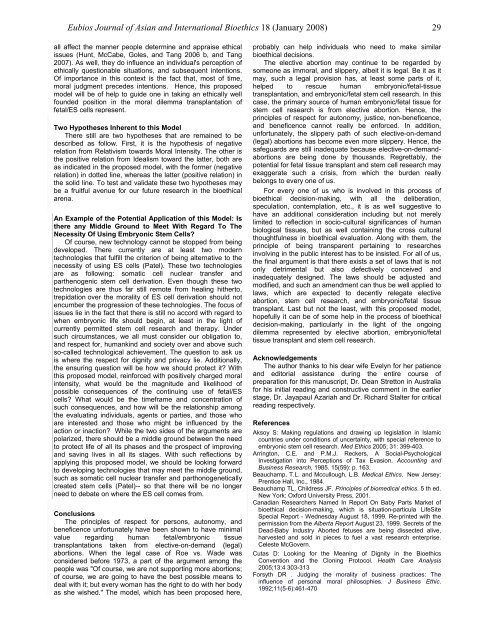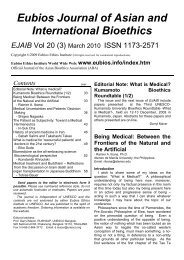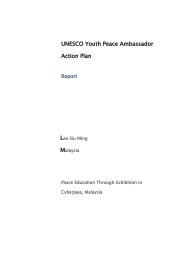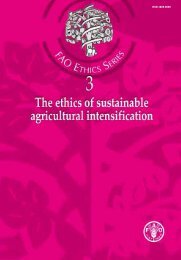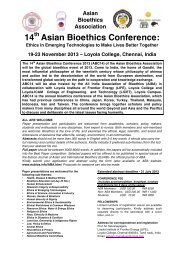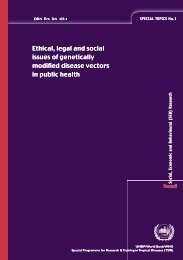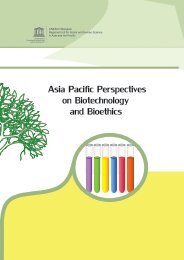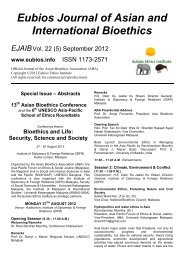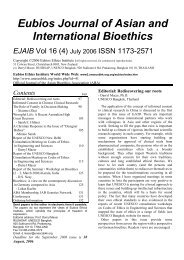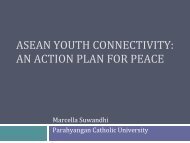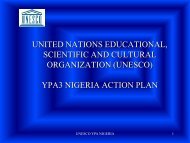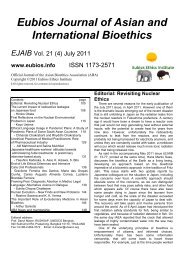Eubios Journal of Asian and International Bioethics EJAIB
Eubios Journal of Asian and International Bioethics EJAIB
Eubios Journal of Asian and International Bioethics EJAIB
- No tags were found...
Create successful ePaper yourself
Turn your PDF publications into a flip-book with our unique Google optimized e-Paper software.
<strong>Eubios</strong> <strong>Journal</strong> <strong>of</strong> <strong>Asian</strong> <strong>and</strong> <strong>International</strong> <strong>Bioethics</strong> 18 (January 2008) 29all affect the manner people determine <strong>and</strong> appraise ethicalissues (Hunt, McCabe, Goles, <strong>and</strong> Tang 2006 b, <strong>and</strong> Tang2007). As well, they do influence an individual's perception <strong>of</strong>ethically questionable situations, <strong>and</strong> subsequent intentions.Of importance in this context is the fact that, most <strong>of</strong> time,moral judgment precedes intentions. Hence, this proposedmodel will be <strong>of</strong> help to guide one in taking an ethically wellfounded position in the moral dilemma transplantation <strong>of</strong>fetal/ES cells represent.Two Hypotheses Inherent to this ModelThere still are two hypotheses that are remained to bedescribed as follow. First, it is the hypothesis <strong>of</strong> negativerelation from Relativism towards Moral Intensity. The other isthe positive relation from Idealism toward the latter, both areas indicated in the proposed model, with the former (negativerelation) in dotted line, whereas the latter (positive relation) inthe solid line. To test <strong>and</strong> validate these two hypotheses maybe a fruitful avenue for our future research in the bioethicalarena.An Example <strong>of</strong> the Potential Application <strong>of</strong> this Model: Isthere any Middle Ground to Meet With Regard To TheNecessity Of Using Embryonic Stem Cells?Of course, new technology cannot be stopped from beingdeveloped. There currently are at least two moderntechnologies that fulfill the criterion <strong>of</strong> being alternative to thenecessity <strong>of</strong> using ES cells (Patel). These two technologiesare as following: somatic cell nuclear transfer <strong>and</strong>parthenogenic stem cell derivation. Even though these twotechnologies are thus far still remote from healing hitherto,trepidation over the morality <strong>of</strong> ES cell derivation should notencumber the progression <strong>of</strong> these technologies. The focus <strong>of</strong>issues lie in the fact that there is still no accord with regard towhen embryonic life should begin, at least in the light <strong>of</strong>currently permitted stem cell research <strong>and</strong> therapy. Undersuch circumstances, we all must consider our obligation to,<strong>and</strong> respect for, humankind <strong>and</strong> society over <strong>and</strong> above suchso-called technological achievement. The question to ask usis where the respect for dignity <strong>and</strong> privacy lie. Additionally,the ensuring question will be how we should protect it? Withthis proposed model, reinforced with positively charged moralintensity, what would be the magnitude <strong>and</strong> likelihood <strong>of</strong>possible consequences <strong>of</strong> the continuing use <strong>of</strong> fetal/EScells? What would be the timeframe <strong>and</strong> concentration <strong>of</strong>such consequences, <strong>and</strong> how will be the relationship amongthe evaluating individuals, agents or parties, <strong>and</strong> those whoare interested <strong>and</strong> those who might be influenced by theaction or inaction? While the two sides <strong>of</strong> the arguments arepolarized, there should be a middle ground between the needto protect life <strong>of</strong> all its phases <strong>and</strong> the prospect <strong>of</strong> improving<strong>and</strong> saving lives in all its stages. With such reflections byapplying this proposed model, we should be looking forwardto developing technologies that may meet the middle ground,such as somatic cell nuclear transfer <strong>and</strong> parthonogeneticallycreated stem cells (Patel)-- so that there will be no longerneed to debate on where the ES cell comes from.ConclusionsThe principles <strong>of</strong> respect for persons, autonomy, <strong>and</strong>beneficence unfortunately have been shown to have minimalvalue regarding human fetal/embryonic tissuetransplantations taken from elective-on-dem<strong>and</strong> (legal)abortions. When the legal case <strong>of</strong> Roe vs. Wade wasconsidered before 1973, a part <strong>of</strong> the argument among thepeople was "Of course, we are not supporting more abortions;<strong>of</strong> course, we are going to have the best possible means todeal with it; but every woman has the right to do with her bodyas she wished." The model, which has been proposed here,probably can help individuals who need to make similarbioethical decisions.The elective abortion may continue to be regarded bysomeone as immoral, <strong>and</strong> slippery, albeit it is legal. Be it as itmay, such a legal provision has, at least some parts <strong>of</strong> it,helped to rescue human embryonic/fetal-tissuetransplantation, <strong>and</strong> embryonic/fetal stem cell research. In thiscase, the primary source <strong>of</strong> human embryonic/fetal tissue forstem cell research is from elective abortion. Hence, theprinciples <strong>of</strong> respect for autonomy, justice, non-beneficence,<strong>and</strong> beneficence cannot really be enforced. In addition,unfortunately, the slippery path <strong>of</strong> such elective-on-dem<strong>and</strong>(legal) abortions has become even more slippery. Hence, thesafeguards are still inadequate because elective-on-dem<strong>and</strong>abortionsare being done by thous<strong>and</strong>s. Regrettably, thepotential for fetal tissue transplant <strong>and</strong> stem cell research mayexaggerate such a crisis, from which the burden reallybelongs to every one <strong>of</strong> us.For every one <strong>of</strong> us who is involved in this process <strong>of</strong>bioethical decision-making, with all the deliberation,speculation, contemplation, etc., it is as well suggestive tohave an additional consideration including but not merelylimited to reflection in socio-cultural significances <strong>of</strong> humanbiological tissues, but as well containing the cross culturalthoughtfulness in bioethical evaluation. Along with them, theprinciple <strong>of</strong> being transparent pertaining to researchesinvolving in the public interest has to be insisted. For all <strong>of</strong> us,the final argument is that there exists a set <strong>of</strong> laws that is notonly detrimental but also defectively conceived <strong>and</strong>inadequately designed. The laws should be adjusted <strong>and</strong>modified, <strong>and</strong> such an amendment can thus be well applied tolaws, which are expected to decently relegate electiveabortion, stem cell research, <strong>and</strong> embryonic/fetal tissuetransplant. Last but not the least, with this proposed model,hopefully it can be <strong>of</strong> some help in the process <strong>of</strong> bioethicaldecision-making, particularly in the light <strong>of</strong> the ongoingdilemma represented by elective abortion, embryonic/fetaltissue transplant <strong>and</strong> stem cell research.AcknowledgementsThe author thanks to his dear wife Evelyn for her patience<strong>and</strong> editorial assistance during the entire course <strong>of</strong>preparation for this manuscript, Dr. Dean Stretton in Australiafor his initial reading <strong>and</strong> constructive comment in the earlierstage, Dr. Jayapaul Azariah <strong>and</strong> Dr. Richard Stalter for criticalreading respectively.ReferencesAksoy S: Making regulations <strong>and</strong> drawing up legislation in Islamiccountries under conditions <strong>of</strong> uncertainty, with special reference toembryonic stem cell research. Med Ethics 2005; 31: 399-403.Arrington, C.E. <strong>and</strong> P.M.J. Reckers, A Social-PsychologicalInvestigation into Perceptions <strong>of</strong> Tax Evasion. Accounting <strong>and</strong>Business Research, 1985. 15(59): p. 163.Beauchamp, T.L. <strong>and</strong> Mccullough, L.B. Medical Ethics. New Jersey:Prentice Hall, Inc., 1984.Beauchamp TL, Childress JF. Principles <strong>of</strong> biomedical ethics. 5 th ed.New York: Oxford University Press, 2001.Canadian Researchers Named In Report On Baby Parts Market <strong>of</strong>bioethical decision-making, which is situation-particula LifeSiteSpecial Report - Wednesday August 18, 1999. Re-printed with thepermission from the Alberta Report August 23, 1999. Secrets <strong>of</strong> theDead-Baby Industry Aborted fetuses are being dissected alive,harvested <strong>and</strong> sold in pieces to fuel a vast research enterprise.Celeste McGovern.Cutas D: Looking for the Meaning <strong>of</strong> Dignity in the <strong>Bioethics</strong>Convention <strong>and</strong> the Cloning Protocol. Health Care Analysis2005;13:4 303-313Forsyth DR . Judging the morality <strong>of</strong> business practices: Theinfluence <strong>of</strong> personal moral philosophies. J Business Ethic.1992;11(5-6):461-470


